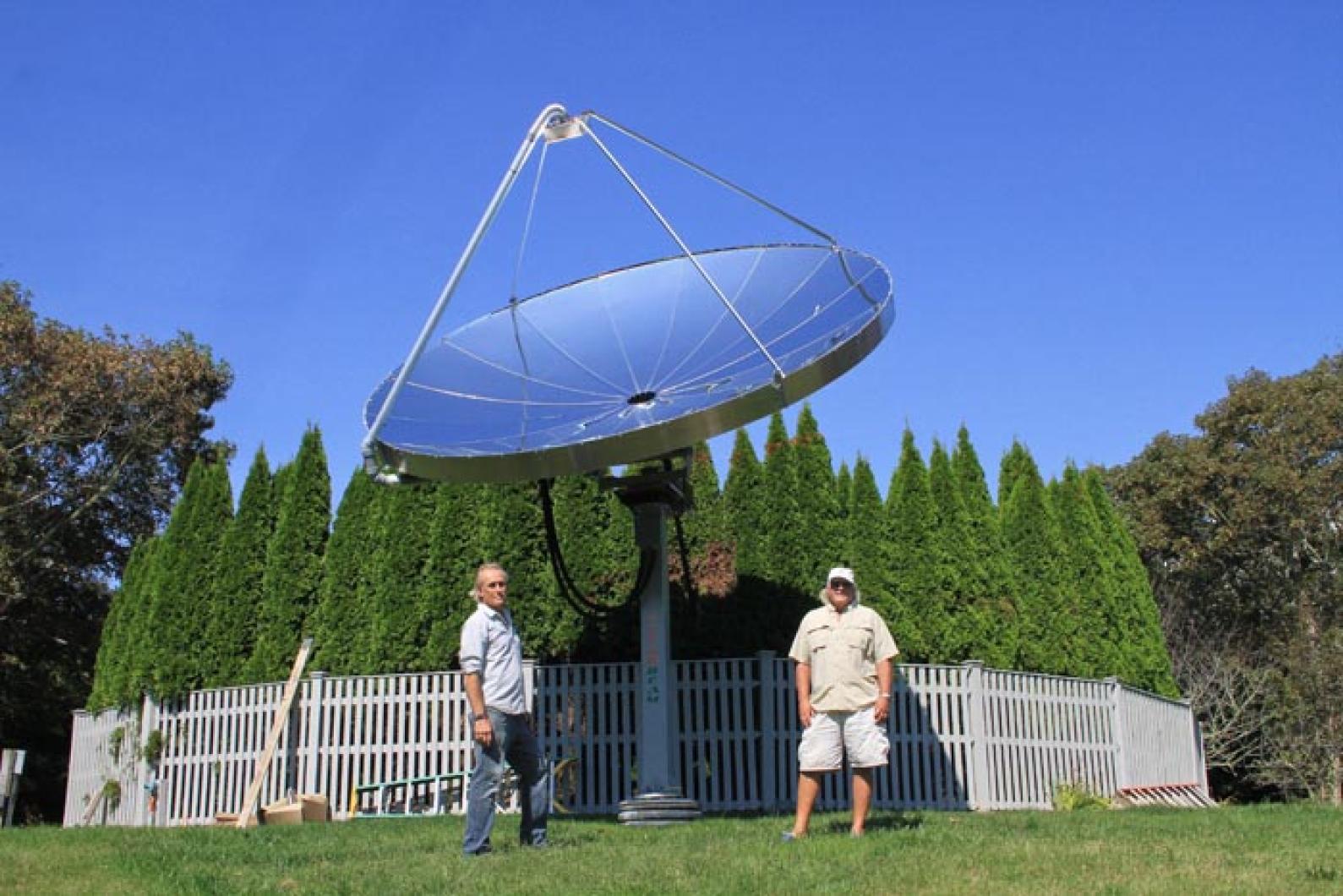Paul Adler climbed up a ladder toward the top of the giant parabolic solar collector in his West Tisbury backyard carrying a long wooden plank.
“You want to see something burn?” he asked.
The giant mirrored dish is essentially a reverse magnifying glass, with the sunlight concentrated at a 10-inch absorber at the dish’s center that is almost too bright to look at. Angling the plank directly into the 1,200-degree beam, the wood instantly ignites.
“You should have brought some hamburgers,” Mr. Adler said.
Running underground from his house, and from his swimming pool, are pipes carrying cold water to the absorber where it is heated to virtually any temperature desirable and circulated back.
Moving like an orchid imperceptibly toward the sun, the collector maximizes the amount of time the dish is exposed to sunlight.
“It’s constantly being updated by a GPS program,” said Gary Stuber, sales manager for Mr. Adler’s recent startup, Southern New England Solar Technologies. “I mean you can see it’s moving now. You can actually see it follow the sun.”
This gives the device a marked advantage over other categories of solar thermal collectors like flat plates (not to be confused with the more familiar photovoltaic panels that generate electricity) or vacuated tubes, which similarly heat water but are immobile and less efficient. In the winter months, when other systems lose heat to the cold weather, Mr. Adler’s model, with less plumbing exposed, in fact becomes more efficient as the atmosphere is cleaner.
It is the only such parabolic concentrator of its kind on a private residence in the world but Mr. Adler is convinced that the technology is about to take off. Two weeks ago the collector, built in the United States by the Canadian company Solartron Energy Systems, earned its certification from the solar rating and certification corporation, making it eligible for the sort of federal and state rebates Mr. Adler received to install it. In Mr. Adler’s case that brought a $45,000 installation cost down to about $25,000.
“I pay $10,000 a year in hot water and this knocks off 85 per cent of that, so I’ll save $8,500 a year,” he said. “My payback should be three and a half years. Anytime you can get less than six years, in my opinion it makes sense. After that I’ll be saving $8,500 a year for probably 20 years and that’s if the price of oil doesn’t go down.”
But Mr. Adler, a Vineyard builder and alternative energy entrepreneur, does not expect the collectors to catch on at first with residential consumers.
“They will be used on some homes but we think that eventually they will probably be used on hotels, car washes, industrial companies — I’m talking to several dairy farms right now in Connecticut — wineries, breweries. Anyone who has a need for large amounts of thermal energy,” he said.
While the collector is designed to heat water, in four months Mr. Adler’s collector will be generating electricity as well once he fits it with photovoltaic cells developed for outer space and not yet on the commercial market. Normal photovoltaic cells would be incinerated by the collector’s high-intensity beam, so Solartron has been collaborating with Boeing to modify the same “triple junction” cells employed by NASA for use on the collector.
“I was going to be putting a wind tower right here,” Mr. Adler said. “I went to wind school, I went to conventions. I even had my permit to put up a wind tower. But then I said if I put a wind tower here I’ve got neighbors that are not that far away and they’re going to complain. I love wind, don’t get me wrong, I think wind is a great resource but it does have issues with neighborhoods.”
Those issues can include flicker (the strobe effect on neighboring properties that some can find disturbing), low-frequency subsonic infrasound (which can prove similarly disturbing) and possible environmental impacts, none of which apply to the solar collector (Mr. Adler thinks it highly unlikely that a bird would fly to its barbequed demise near the absorber plate).
“I want to see how long I can go before my neighbors find out about it,” he said standing next to the 16-foot-tall dish.
Inside his house Mr. Adler pulled up a graph of the collector’s performance on his computer. Each day at sunrise the machine wakes up, about the same time as his kids he says, and begins tracking the sun. When the sun sets, so too does the dish, lying in a flat position. Because of the dish’s mobility it is able to generate a steady plateau of heat throughout the day, as opposed to immobile units which generate progressively more energy before peaking and then diminishing over the course of the day.
Back outside the dish was in a new position, lying more flatly as the sun moved overhead.
“The solar industry can really help fuel this third industrial revolution that we’re about to see,” said Mr. Stuber. “We haven’t seen it here yet but as people realize that the system that we have right now is not going to work long-term this revolution that is about to happen in energy could provide a huge influx and jobs to this economy. It’s only a matter of time.”





Comments (1)
Comments
Comment policy »